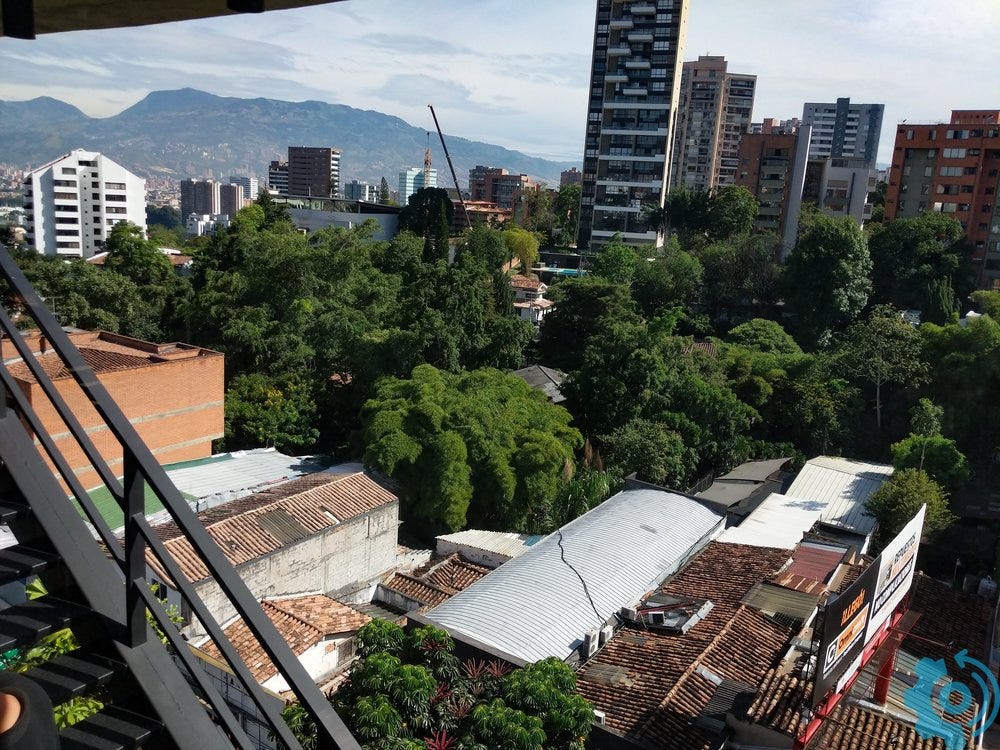Engineering Transformation in Medellin - a travel case study
This year when temperatures rose above 40C, I skedaddled to the land of Eternal Spring. Once the notorious most dangerous city in the world, sadly known for its past with narcos and violence, the city of Medellin has been transformed to a tourist must-see destination. Its transformation from those dark days to a global hub of innovation is many thanks to the public and social programs, including massive engineering projects, which make the city safe, vibrant, and enrapturing.

From industrial city to knowledge city

Even through the darkest days of Pablo Escobar in 1991 (an annual homicide rate that peaked the equivalent of 10 deaths a day in Austin) the city continued construction of the metroline which opened in 1995. This immaculate public transportation system links rich and poor neighborhoods with social and physical connectivity. When I think of US cities, this is something we don't do, whether from lack of public or financial support in most urban areas. However in Medellin, this project foreshadows the decades of architectural reverence and political backing that in the 2000s will play a part in the city's transformation.
Unlike engineering in the US, the wealthier citizens live in the flat valleys and the poorer citizens live up in the earthquake-prone hills on the outskirts of the city. Las colinas. Los cerros. Las comunas. These were settled by people who were displaced by the urban centers or fled violence in the rural areas. These settlements were once considered illegal by the government; poverty was exacerbated by the multiplicity of drug actors like gangs, a military group, guerrillas, and drug lords.In the vertical streets of the comunas ten years ago were fronteras invisibles. These are the invisible borders which split up the informal territories in the hills. This month, I walked across some of these invisible borders through beautiful park land. Our guide was giving us a tour of the greenbelt when a few young boys walked by. "Chicos! Bien o que?!" and they respond, "bien!". Everyone is friendly here. If you're not friendly, you will be called out.

Today, these areas have been fully integrated in Medellin with on-going social urbanism projects including utilities and transportation programs. In particular, the transportation programs (metrocables and electric escalators which reduced commute times into the city from 2 hours to just a few minutes) were part of the reason the city was selected in 2012 to be the world's City of the Year. In the award, Medellin isn't just recognized for the social mobility of these programs but also because these advancements in public transportation reduce burden on the city pollution, spur private investments and promote social equity.
In this case study, I want to look at four different types of engineering projects: public transportation, public utilities, cultural programming, and democratic architecture.
Obviously, there were many other programs like tenure land grants and Medellín la más educada, but the physical projects remain as reminders of change. This isn't saying that Medellin is a glimmering, Shangri-la. It's not. When people say Medellin is "safe", what they mean is that they were hyper vigilant, not daring to walk a couple blocks alone at night and always with a thought to pickpockets. But my city isn't perfect either. Transformation doesn't mean perfection, it just means that Medellin as an innovative, engineering city has a story to tell. In this global world, we need that story.
[Medellin is] representative of the global challenge facing many cities, especially in Africa, Asia and Latin America. The fact that the situation in Medellín was exacerbated by the drug-fuelled battles fought on the rooftops of its comunas only makes its transformation all the more exceptional. citation
As I write this, I struggle because I know that this isn't personal for me. The Paisas I met all knew of a tragic personal story. Those are the stories that drove transformation en los años 80s y 90s and, quite honestly, aren't mine to tell. So I won't be talking about one of the most important threads: the people. And I won't be talking about tragedy - those are conversations that belong to those communities. I do want to paint a canvas of the possibilities of engineering, as it plays with policy and the two base layers of Maslow's pyramid. My words are based in my interpretation that an elevation from poverty to economic capital is a measurable way to define progress and a building block for safety, basic needs, and access to economic mobility. I am assuming that a universal goal, even for those with different corporate or political interests, is to protect those human rights. Though I know... that's not always the reality.

Public Transportation
One of my favorite afternoons was spent with a tour through Comuna 13. It was a party.Our first, and most famous project, are the electric escalators. This neighborhood was specifically chosen due to its isolated location, stronghold for violence, and controversial peace raid. The escalators reduced transit times into the city from 4 hours to a number of minutes ascending 1,300 feet for 12,000 residents. This allows people to more efficiently get to jobs and resources in the city. The only place in the world where escalators engineer a bit more social equity.
My latest yt video has no engineering in it at all - just art, dance, and culture! Que chévere!
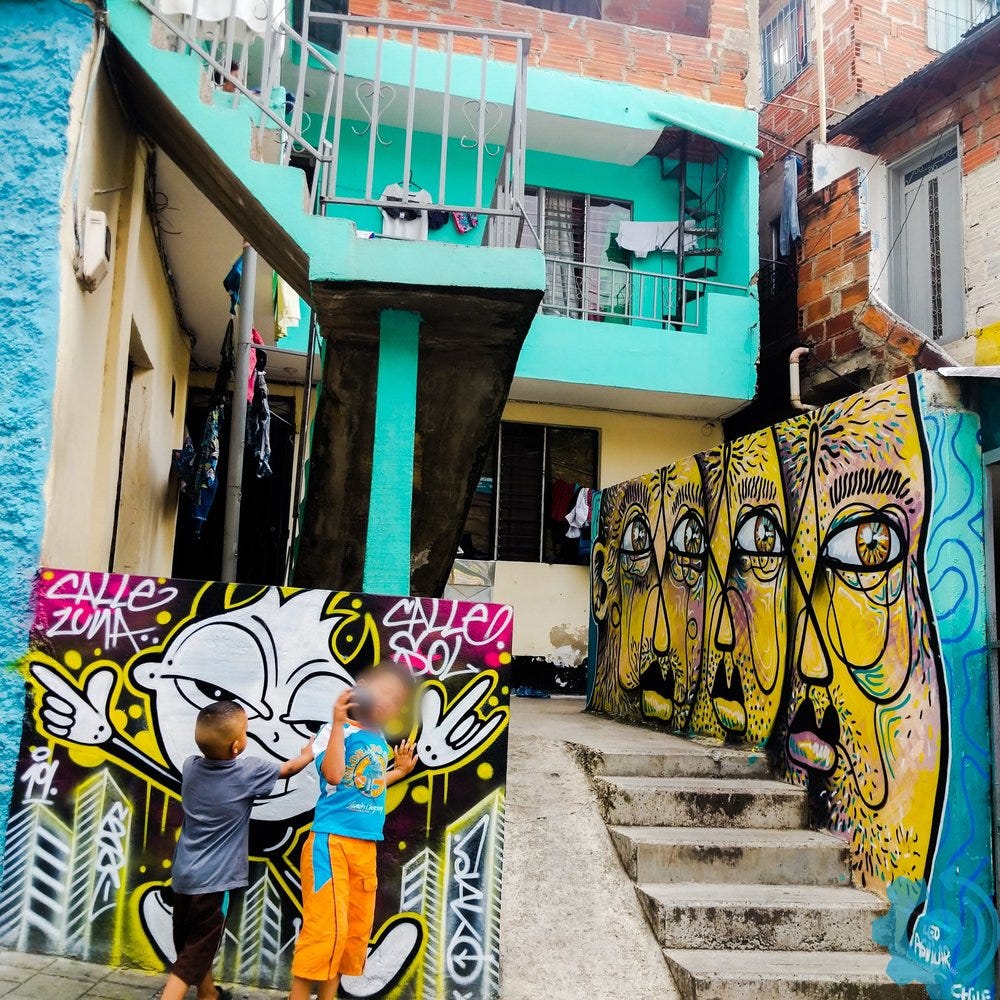
I've already mentioned the metro system which uses gondolas in the world's first fully integrated urban CPT system. Just like you'd jump on a gondola with your skis, you can embark at different metro stops to head up into the hills. A big tourist attraction is the Parque Arvi with its many hikes and farmer's market up in the mountain.
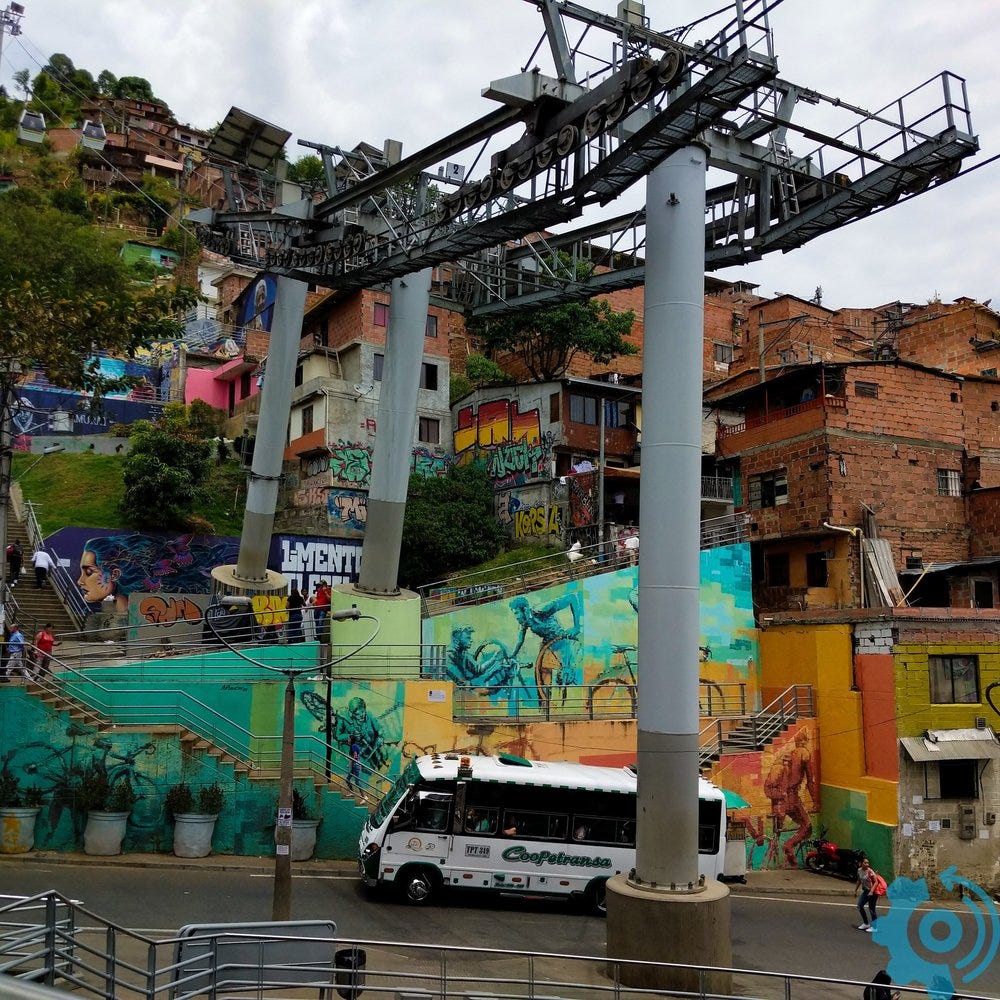
On the could-be-better side of things, ridesharing is alegal which only sort of detracts drivers from using it. It's said to be safer than taxis and easier to use if your spanish is rusty. Drivers are not always reliable (though I know a Paisa who'd argue with me on this point). It's also a bit awkward due to its alegality and the fact that Colombia has threatened to suspend the driver's license for 25 years to anyone caught being a driver. People aren't scared of this, they just ask that you sit up front and pretend like you know them.
Which only proves that it's useful, but not necessary, to have government-backed policies in transportation. The important part is that communities are part of the decision. Communities will do what's right and makes sense for them, regardless of the law.

Public Utilities
The next project is called "integrated slum upgrading" and started in the 1950s to level up informal settlements. It included provisions for household connections into the public utilities, quite a feat given the risky terrain and sociopolitical factors. In Medellin, the utilities are run by a public-private partnership (P3) conglomerate E.P.M. which is composed of 12 companies that provide water, sewer, gas, phone, and electric.
What's most intriguing to me is that because EPM's domestic footprint is capped by law, they've begun to reach out internationally and provide utilities to Chile, Mexico, and other countries. And what does the 9th largest company in Colombia do with all those profits? They turn around and feed 30% (about $500 million) right back into cultural planning like building plazas and parks in Medellin.
Public utilities are non-negotiable in Medellin. Each neighborhood is separated into Estratos numbered 1-6 where 6 is the highest socioeconomic scale. The higher the number, the higher the cost of services. In 2015, roughly 300,000 people live in the lowest designated strata, and 80% of Medellin's population in the lowest third. Social equity still has a long way to go.
Internationally, EPM is recognized for its aggressive policies for service coverage in poorer communities and it's commitment to the people: growth, social accountability, and improving the quality of life. Architecturally they have an intelligent building which I find fascinating that the public utility is participating in this extent of thought leadership.
Cultural Programming

In Medellin, urban interventions coupling cultural programming with engineered spaces has played a critical part in the transformation of the city. As you walk around the city, or any major city in Latin America, there are community spaces. As the sun goes down, you can see 20-somethings hanging with their dogs in the public parks cracking open a cerveza. Benches are filled with kids trading spit. The places are zoned and built differently than our grid-locked cities in the US. It's a parallel phenomenon: the level of planning we do and don't do builds the culture; culture builds the level of planning.
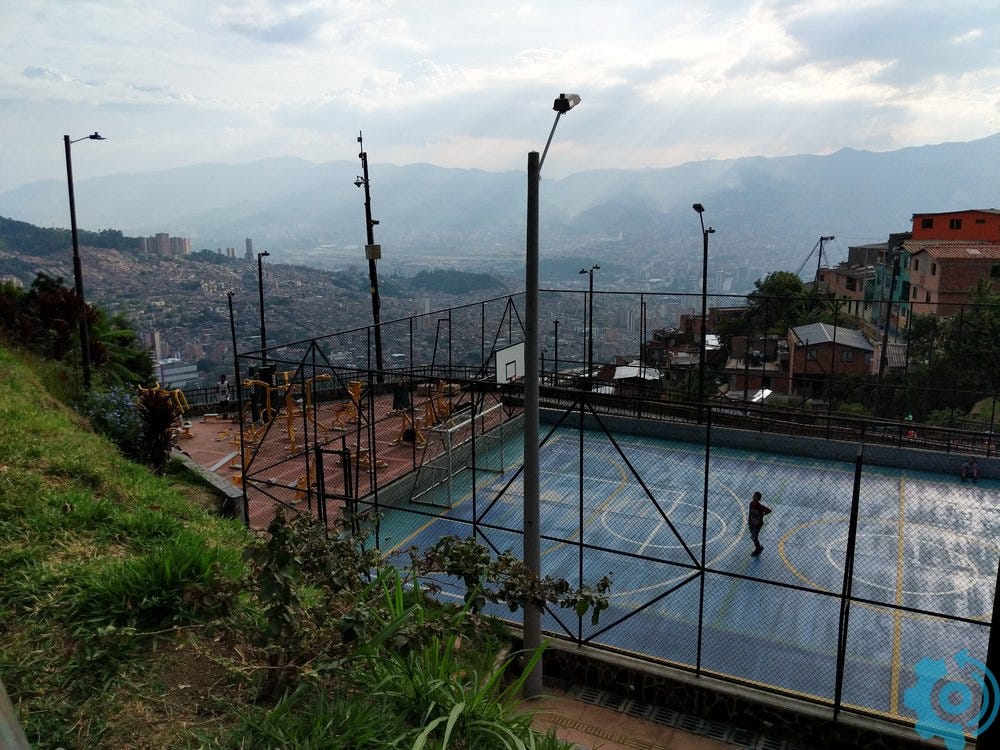
Planning is just one aspect of it. In some of the larger green parks, there are free yoga morning classes put on by INDER, a government-funded collaboration for sports and recreation. This is just one example of cultural programming.Our next set of big projects are called Unidades de Vida Articulada or UVA. Not to be confused with las uvas. This is a joint project that is funded by the mayor's office and EPM, often on EPM land, designed by EDU, and executed by INDER. Citizens are actively engaged in the building of sports, recreation and cultural venues which play with the five senses and are recycled from plots that were previously inaccessible or poorly used. The ideas and actions are developed by these players and the desires of the communities, but engineering and funding of $86M USD is what puts this transformation into play.
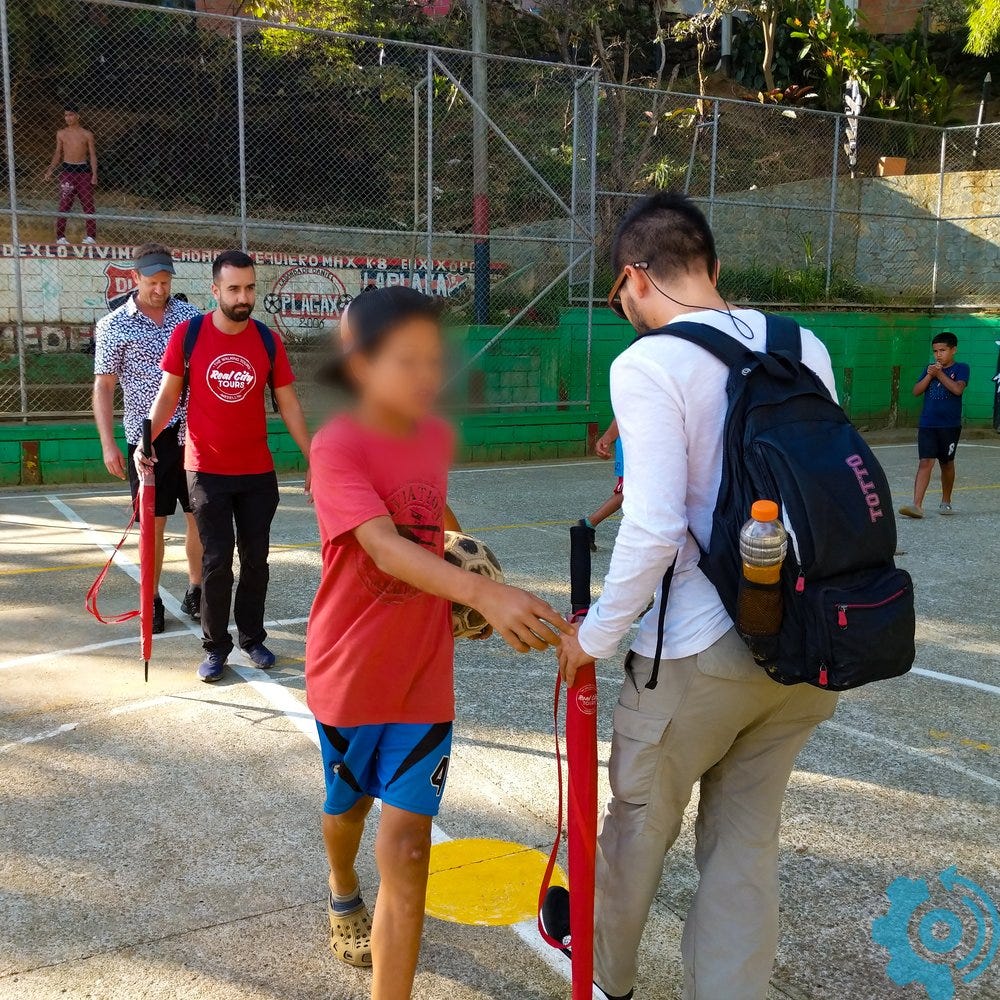
Though EPM funds some of the cultural programming, it's foundation is erected through community culture which drives policies. Garages are transformed into small tiendas. Walking the neighborhood is common. In this way, people police each other using the etiquette of their culture. In the US we halt that ability because we value heavy-handed regulation (and litigation) to smooth out our city functions and differing cultural norms.

Each social policy is put into measurable action by the engineering projects. A project, from a wastewater line buried underneath the city or a massive highway project displacing homeowners, has consequences. As engineers, its easy to think that what we are doing is unbiased. That politicians or clients have asked us to design x, y, z and we're doing it. It's important to remember that each decision effects the people it serves differently.
Democratic Architecture

Grand architectural landscapes are common throughout Medellin. It's hard to get on a metro in Medellin without looking out and wondering, "What's that building?". They are interactive social nodes, such as massive libraries or reinvented park spaces, and house the cultural and educational programming geared towards low income households.
For once, architecture-as-spectacle is not being used as a tool to market the culture industry, but to make poverty visible citation
It's so ingrained in the city's fiber that mayoral candidates run on platforms of visionary architectural planning. They know that it's more than just physical architecture, it's social architecture. Because of this, many of them are located in the hills and more difficult to visit. They're not for the tourists. It's this fierce culture of architectural elevation that provides civic pride and the physical reminders of the power of social urbanism.

Architecture alone obviously doesn’t account for the drop in homicides, but the two aren’t unrelated, either. Around the world, followers of architecture with a capital A have focused so much of their attention on formal experiments, as if aesthetics and social activism, twin Modernist concerns, were mutually exclusive. But Medellín is proof that they’re not, and shouldn’t be. Architecture, here and elsewhere, acts as part of a larger social and economic ecology, or else it elects to be a luxury, meaningless except to itself. citation
If you're an architecture buff, there's many more examples of this all over the city. 10 schools, 5 grand library parks, an interactive parque, botanical gardens and more. You'll just have to visit yourself to see it.
So what do we learn from all this? Transformation is multi-faceted. It's just as much social and political as it is structural.

Cities are beginning to understand this. They don't just create projects without public input anymore. Engineering isn't done in a cubical. What the engineer thinks makes most sense in terms of design (cost, constructability, land availability, technical solutions) may have a blind spot to unintended social or political consequences. But that just makes it all the more interesting as problem-solvers. In today's world, our problems are just a bit more complex so we need to be a bit more agile to think of out-of-the-box solutions. We have to be intentional about pausing and recognizing others' perspectives even if it makes our jobs a bit more cumbersome with those extra review cycles.
Medellín has come a long way from its past, sending a powerful signal that inclusive and collaborative governance can overturn even the most difficult circumstances. citation
Reading: I just finished Becoming by Michelle Obama and am still working through Hero of Ages by Brandon Sanderson. I also read Melinda Gate's Moment of Lift which is what really spurred my research about structural inclusivity of marginalized people.
Working: I'm doing a few non-project tasks for my new role (promotion?) as executive advisor to the VP for global solutions & technology. The part of our org that connects the right specialized technologists to our projects and helps with technologist career development!
Listening: Rosalía - she killed at ACL this year. I am in loooooove.





